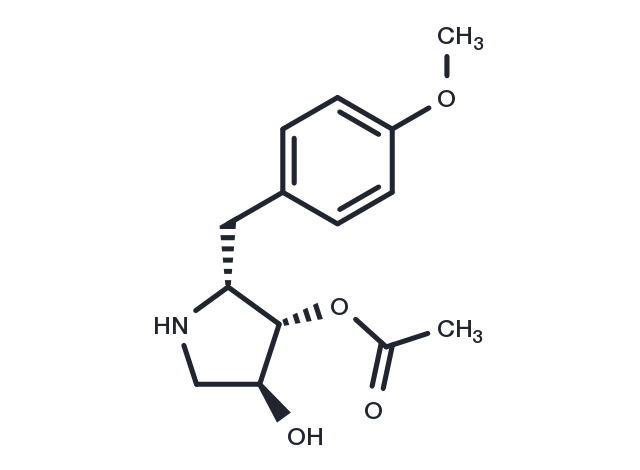Powder: -20°C for 3 years | In solvent: -80°C for 1 year


Anisomycin (NSC-76712) is an antibiotic isolated from various Streptomyces species. It interferes with protein and DNA synthesis by inhibiting peptidyl transferase or the 80S ribosome system.

| Pack Size | Availability | Price/USD | Quantity |
|---|---|---|---|
| 10 mg | In stock | $ 46.00 | |
| 25 mg | In stock | $ 63.00 | |
| 50 mg | In stock | $ 90.00 | |
| 100 mg | In stock | $ 161.00 | |
| 200 mg | In stock | $ 225.00 | |
| 1 mL * 10 mM (in DMSO) | In stock | $ 50.00 |







| Description | Anisomycin (NSC-76712) is an antibiotic isolated from various Streptomyces species. It interferes with protein and DNA synthesis by inhibiting peptidyl transferase or the 80S ribosome system. |
| In vitro | Anisomycin (3 μM) decreases protein synthesis in MDA16 and MDA-MB-468 cells, and reduces colony formation by MDA-MB-468 cells. Anisomycin causes an increase in the number of apoptotic cells in MDA-MB-468 cultures, but not in MDA16 cultures. Anisomycin actives JNK phosphorylation in MDA-MB-468 cells.[2] In U251 and U87 cells, anisomycin?(0.01-8 μM) inhibits the cell growth in time- and concentration-dependent manners with the IC50 (48 h) values of 0.233 and 0.192 μmol/L, respectively. Anisomycin?(4 μM) causes 21.5% and 25.3% of apoptosis proportion in U251 and U87 cells, respectively, and activates p38 MAPK and?JNK, while inactivated ERK1/2. Anisomycin?(4 μM) reduces the level of PP2A/C subunit in a time-dependent manner in U251 and U87 cells.[3] Anisomycin inhibits EAC cell proliferation in concentration-dependent manner.[4] |
| In vivo | Peritumoral administration of anisomycin (5 mg/kg) significantly suppresses Ehrlich ascites carcinoma (EAC) growth resulting in the survival of approximately 60% of the mice 90 days after EAC inoculation.[4] |
| Kinase Assay | JNK phosphorylation: 500,000 cells/well are seeded in 6-well plates and incubated overnight. Cells are then incubated for 1 h with test compounds or DMSO as vehicle control (?nal concentration 1% v/v). Puromycin is added (?nal concentration of 18 μM) and cells incubated for a further 10 min to label nascent polypeptide chains. Background labelling is determined by incubating cells without puromycin. Cells are then washed in HBSS, harvested by scraping and centrifuged (300 g, 5 min). Cells are resuspended in 0.5 mL 50 mM DTT containing phosphatase inhibitors and incubated at 95℃ for 10 min. Samples are then snap frozen in liquid nitrogen and stored at -20℃ until blotted. Samples (20–30 μg protein/sample) are blotted onto a PVDF membrane. The membrane is blocked and incubated with anti-phospho-Thr183/Tyr185-JNK antibody overnight at 4℃. Secondary antibodies are used to label the primary antibody and detected using an infrared scanner. The intensity of the ?uorescence signal for anti-phospho-JNK antibody is background corrected and normalized for loading. |
| Cell Research | For the assay, EAC cells are plated in 96-well plates at a density of 10,000 cells/well/200 μL of medium. The cells are treated with the different concentrations of anisomycin for 48 h. Adriamycin (500 ng/mL) is used as a positive control. 0.5 mg/mL of MTT is added to each well. 4 h later, the formazan product of MTT reduction is dissolved in DMSO, and absorbance is measured at 570 nm using a Model 680 microplate reader.(Only for Reference) |
| Synonyms | Flagecidin, NSC 76712, Wuningmeisu C |
| Molecular Weight | 265.3 |
| Formula | C14H19NO4 |
| CAS No. | 22862-76-6 |
Powder: -20°C for 3 years | In solvent: -80°C for 1 year
Ethanol: 13.3 mg/mL (50 mM)
DMSO: 26.5 mg/mL (100 mM)
You can also refer to dose conversion for different animals. More
bottom
Please see Inhibitor Handling Instructions for more frequently ask questions. Topics include: how to prepare stock solutions, how to store products, and cautions on cell-based assays & animal experiments, etc.
Anisomycin 22862-76-6 Apoptosis Cell Cycle/Checkpoint DNA Damage/DNA Repair MAPK Microbiology/Virology Antibiotic JNK Antibacterial DNA/RNA Synthesis Bacterial Inhibitor NSC-76712 Flagecidin NSC 76712 inhibit Wuningmeisu C NSC76712 inhibitor
